'Twin Peaks' Part 14 recap: Who is the dreamer?
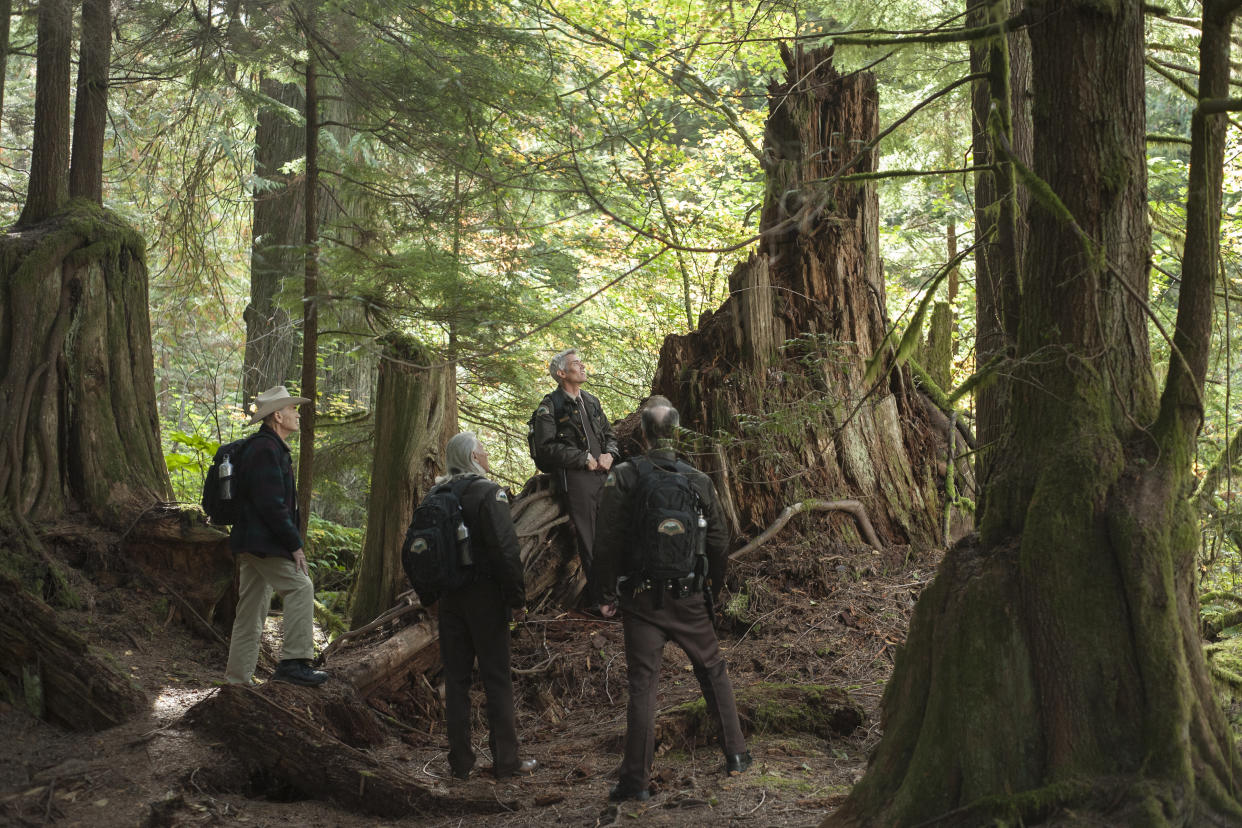
Warning: This recap for Part 14 of Twin Peaks contains spoilers.
Before screenings of his 2006 movie Inland Empire, David Lynch would read some lines from the ancient Sanskrit scripture The Upanishads: “We are like the dreamer who dreams and then lives inside the dream.” The same loosely translated phrase appears in Part 14 of Twin Peaks: The Return, whispered by Monica Bellucci to Gordon Cole (David Lynch) in his black-and-white Parisian dream. It’s a line that sets the tone for an episode deeply fascinated with dreams and mysticism and the fractured state of human subconsciousness.
Usually, when people start talking about their dreams, I turn into Dennis from It’s Always Sunny In Philadelphia and want to start yelling and banging my head against the wall. But Lynch has spent his entire career communicating ideas via dream logic, using it to expose and understand the fragility of reality and the complexities of the human mind. Dreams can seem vivid the moment we awake from our slumber but become fragmented as time passes, turning something that once felt real into an illogical impossibility the harder we try to recall. Our own memories can be just as unreliable, fading and changing as we grow older, reshaping the past into something merely posing as reality. In Twin Peaks, the stories are told through this prism of scattered dream logic, making it difficult to separate fact from fiction.
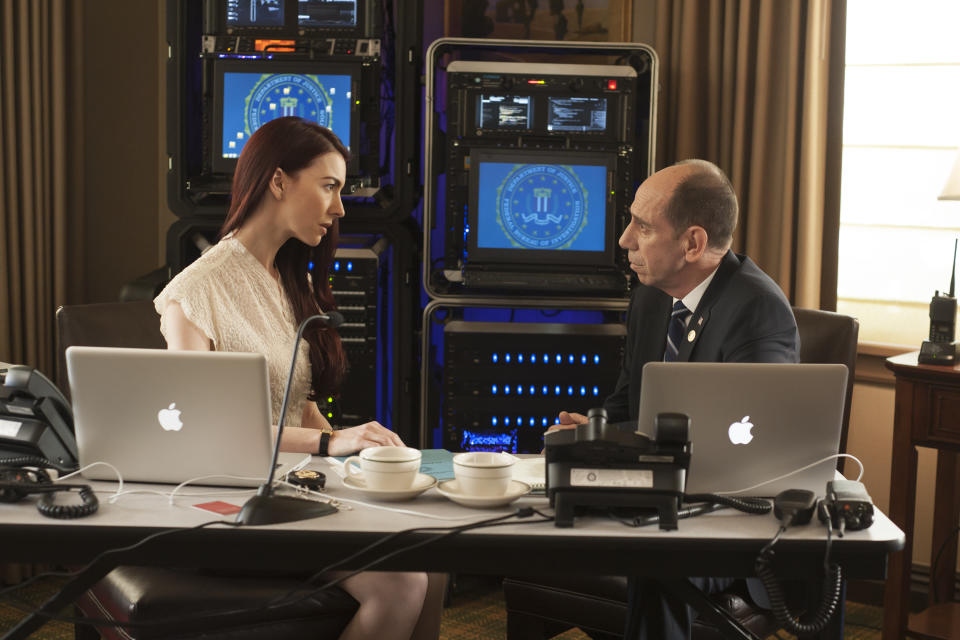
BUCKHORN, S.D.
Part 14 begins with Albert Rosenfield (Miguel Ferrer) telling Tammy Preston (Chrysta Bell) a dream-like story about the first Blue Rose case. In 1975, two young field agents entered a motel room in Olympia, Wash., to find a woman, Lois Duffy, standing over the bullet-wounded body of her presumed doppelgänger. “I’m like the blue rose,” the identical Duffy said before she died and then disappeared. Albert recalls the details as if he lived it, but in fact, the agents who witnessed the event were a young Gordon and Phillip Jeffries (David Bowie), the experience kick-starting their fascination with the supernatural.
The story has become a tale — presumably passed down by Gordon — that not only acts as an origin of the Blue Rose cases but as a test. “Now, what’s the one question you should ask me?” Albert poses to Tammy, recalling a similar conversation between Agents Chet Desmond and Sam Stanley in Fire Walk With Me. Tammy knows it’s the blue rose, and Albert asks the significance. “Not something found in nature … not a natural thing … conjured … a tulpa,” Tammy answers. A tulpa comes from both Tibetan and Indian Buddhism and can be defined as “a concept in mysticism of a being or object which is created through spiritual or mental powers.” Essentially a manifestation of the mind, or as the Samaññaphala Sutta scripture describes it, a “mind-made body.” It’s a concept that can be used to describe many of the supernatural entities in Twin Peaks, and it ties directly to both Lynch’s spirituality and the show’s connection to ancient mysticism (we all remember Agent Cooper using the Tibetan method of stone throwing in the original series).
Our detour into spiritualism goes further when Gordon enters the room, having just gotten off the phone with Lucy (Kimmy Robertson) and Sheriff Frank Truman (Robert Forster), who informed him of their investigation into the two Coopers. Gordon mentions having “another Monica Bellucci dream,” to which Albert rolls his eyes. But the dream isn’t some throwaway teenage-style fantasy; it is packed with detail and meaning. The Italian actress, playing herself, meets Gordon at a café in Paris, she brings friends, and Cooper (Kyle MacLachlan) is there, but Gordon can’t see his face. She then says the ancient phrase, “We are like the dreamer who dreams and then lives inside the dream.” Gordon seems familiar with the quote, but it’s the next line that haunts him, when she asks, “But who is the dreamer?”
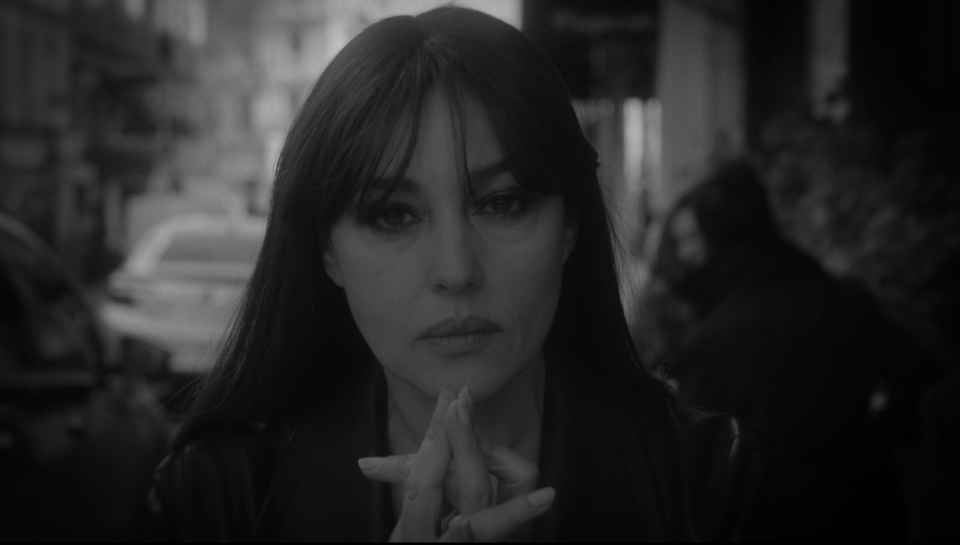
Gordon, still in the dream, looks over his shoulder, glimpsing a faded memory of himself as a younger man, back in the old Philadelphia offices. He describes a “powerful uneasy feeling” as we rewatch the FWWM scene where Cooper starts to tell Gordon of a dream he had before being interrupted by the reappearance of the missing Phillip Jeffries, who points at the young Coop and asks Gordon, “Who do you think that is there?” Before any discernible information can be gathered, Jeffries disappears, never to be seen again. It should also be noted that in this scene, not shown in the episode, Jeffries states, “We live inside a dream!” Is Jeffries a manifestation of the mind — a tulpa? As much as I’m holding out for a surprise Bowie cameo, I think this is as close as we’re going to get, but it’s still fantastic to see the series pay tribute to the late performer.
The Jeffries memory, which itself is a surreal moment, is blended into Gordon’s abstract Bellucci dream and it surprises him — he’d forgotten about it. I’m not sure how you forget a Southern-accented David Bowie shouting about “Judy” and then vanishing into thin air, but Gordon’s seen a lot of weird s*** over the years. “Damn!” he shouts, “I hadn’t remembered that! Now, this is really something interesting to think about.” Albert looks on pensively, admitting that he’s starting to remember, too. It goes back to the idea of memories becoming as unreliable as dreams, blurring the lines between realities.
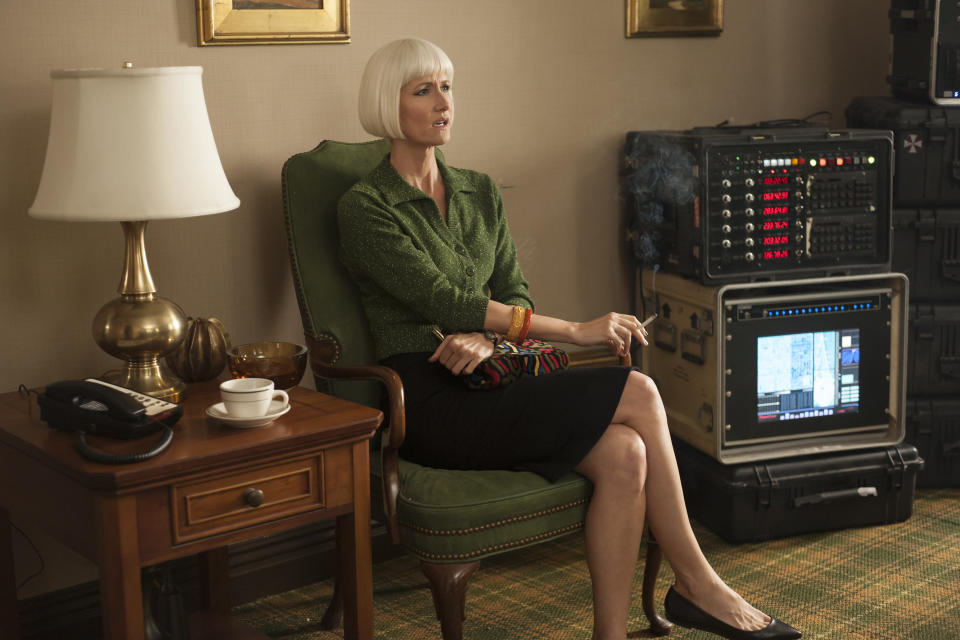
Speaking of unreliable, Diane Evans (Laura Dern) has a story of her own. Albert brings the new Blue Rose deputy up to speed on Major Briggs’s (Don Davis) time-warped death and reveals they found a wedding ring in his stomach inscribed with the message “To Dougie Jones from Janey-E.” Diane informs us her estranged half-sister is called Janey, and she is married to a man named Douglas Jones. “Janey-E was her nickname,” she tells the Blue Rose crew. While this information is certainly plausible — both women conduct themselves with an aggressive feistiness, plus that wayward “E” could stand for Evans — it’s hard to trust anything Diane says given her secret midnight texting. It could be a trap to lure the FBI to Las Vegas where you sense something wicked is approaching the Joneses. But I’m all for the FBI taking a road trip to Vegas if it means Gordon and Albert get to meet Dougie!
TWIN PEAKS
Tall tales and unbelievable stories are all the rage back in Twin Peaks, too. The sheriff’s department silver foxes — Truman, Hawk (Michael Horse), Bobby (Dana Ashbrook), and Andy (Harry Goaz) — pack their sandwiches (just cheese for Andy) and head into the woods to search for Jack Rabbit’s Palace and the coordinates left by Major Briggs. When the group come upon a large, coiled tree stump, Bobby reminisces about childhood trips with his father where they would sit and “make up great tall tales.” You get the sense those tall tales were in fact very real to Major Briggs if what happens next is anything to go by.
Behind a cloud of electric fog, the men find Naido (Nae Yuuki), the eyeless Asian woman last seen falling through space in Part 3’s mind-bending Purple Room sequence. She lies naked in the forest beside some sort of gooey lava pit, alive but clearly disorientated. I wonder if this is where Cooper was supposed to manifest before he was tricked into trading places with Dougie? Naido tries to speak, but her whispered chirps are unintelligible, acting as the perfect metaphor for an episode about the difficulty of communication.
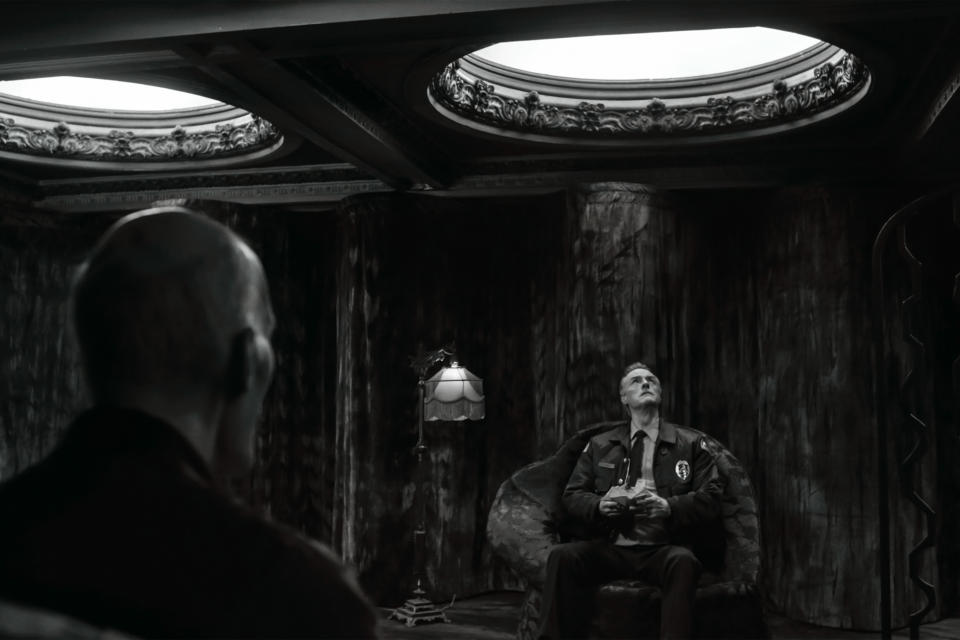
As Andy tends to Naido, the sky opens up above them, the same spiraling vortex which Gordon saw in Part 11. The men stare into the center of the tunnel and Andy is transported into the black-and-white world where the Fireman (formerly known as the Giant, played by Carel Stuycken) sits. It’s thrilling to see Andy, usually a comic character, placed in a serious scene steeped in Twin Peaks mythology. Here, another story is told, in the form of visual flashbacks through a porthole — images of the Experiment, BOB, the Woodsmen, Laura Palmer, the two Coops, and the No. 6 telephone pole flash before Andy’s eyes. He returns to his colleagues with confidence and a sense of purpose, telling them they need to protect Naido because someone wants her dead. I previously questioned whether Naido was helping or hindering Cooper back in Part 3; I’m now confident she was on his side.
Naido is placed in a cell at the sheriff’s department opposite Deputy Chad (John Pirruccello), who was arrested earlier for his dodgy dealings. The blind woman again tries to communicate, but it’s just noises — noises mimicked by a wounded drunk in another cell, driving Chad to the point of insanity. All three are suddenly howling like demented monkeys, bringing to mind another famous Twin Peaks jail scene from the pilot when Bobby and Mike bark at James.
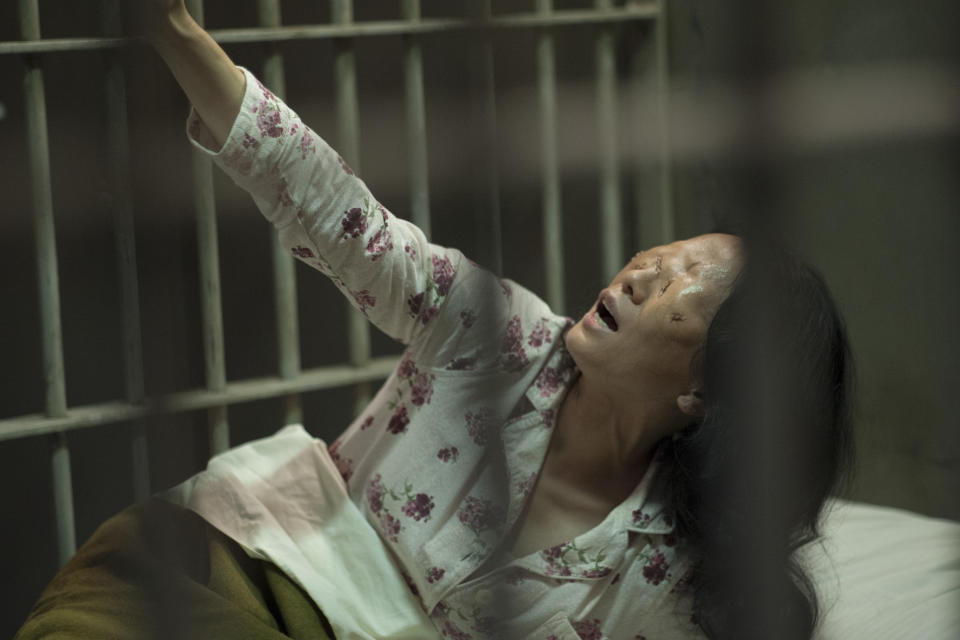
The Fireman, who feels like another tulpa, also features in the story told by Freddie (Jake Wardle), who works with James as a security guard at the Great Northern. Freddie, rocking the sort of Cockney accent I thought died with Dick Van Dyke, is reluctant to tell his story because of how preposterous it sounds. It turns out Freddie had his own vortex voyage, where the Fireman instructed him to purchase a green gardening glove that would give him the “power of a pile driver” and then to come to Twin Peaks where “he will find his destiny.” It’s an odd story and a long scene given to a character who was only glimpsed for a few seconds back in the premiere.
Freddie’s story may seem ridiculous, like remnants of a half-forgotten dream, but as the scene with Sarah Palmer (Grace Zabriskie) proves, the reality in Twin Peaks is often stranger than fiction. After being harassed by a “Truck You” T-shirt-wearing sleazebag at the bar, Sarah threatens to eat him if he doesn’t back off. He refuses to take her threat seriously until she removes her face, the same way Laura did in Part 2, but instead of a bright light underneath, it’s a black void. We see sparks of electricity, a white hand, and a creepy, smiling face which reminded me of the nightmarish Laura Dern visage in Inland Empire. These are the dark horrors that occupy the mind of a woman whose memories haunt her every day (and also hint that Sarah is perhaps the frog-bug swallowing girl from Part 8). Sarah unleashes this darkness on Mr. Truck You, biting a chunk out of his neck and watching him fall to the floor bleeding. Then she spins her own tall tale, telling the barman “He just fell over.”
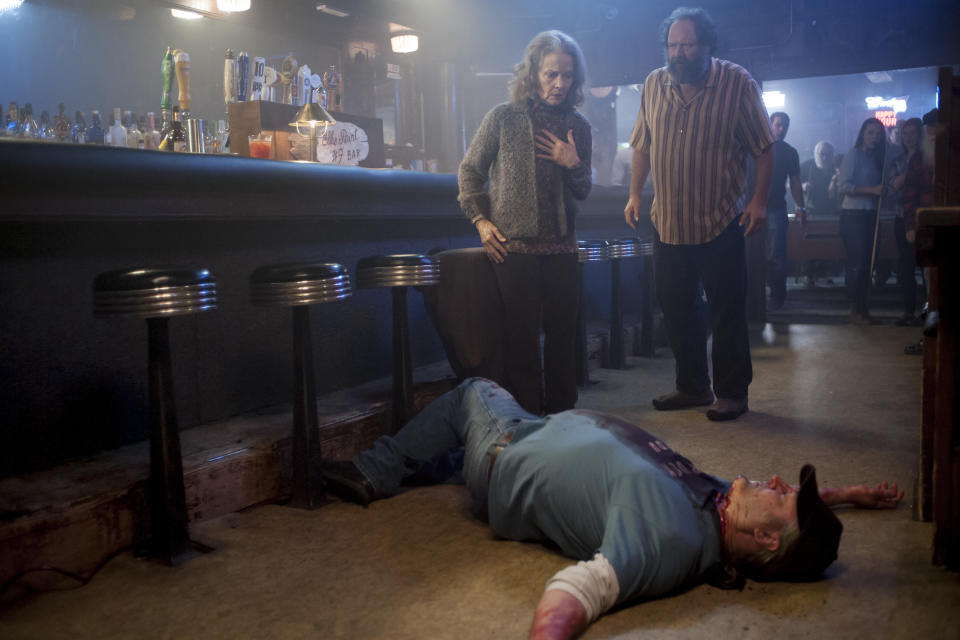
The episode ends where it so often does, at the Roadhouse, with two more random women (one played by Emily Stofle, David Lynch’s wife) gossiping about people we’ve never met. But where scenes like this have been frustrating in the past, here the conversation speaks to Part 14’s idea of troubled communication and fragmented storytelling. One of the women, who we learn is the daughter of Tina (the woman Audrey mentioned in Part 12), talks about how the missing Billy ran into their kitchen, blood gushing from his nose and mouth like a waterfall. But her recollection of this event is hazy: “I can’t remember if my uncle was there,” she keeps repeating as if trying to remember a muddled dream.
It comes back to Monica Bellucci’s question — “Who is the dreamer?” Whose dream are we inside? Whose story are we following? I don’t think the series is literally taking part in the dreams of Cooper or Gordon or anyone else, but it’s an important question for understanding the fractured nature of Lynch’s storytelling, particularly in this series of Twin Peaks, which delights in its free-form, disconnected dream-like narrative.
THOUGHTS FROM ANOTHER PLACE
— As pointed out by a user on Reddit, Gordon’s dream café where he meets Monica Bellucci is the Creperie Plougastel in Paris, which is two doors down from Lynch’s art exhibition space “Plume of Desire.” Also, a pad with notes for this scene can be glimpsed in the recent documentary David Lynch: The Art Life.
— The short scene at the FBI office in Vegas where Mad Men‘s Jay R Ferguson yelled at his assistant was a Lynchian comic delight. After his assistant wonders how they’re going to track down the right Douglas Jones, Ferguson’s character bellows: “Wilson, how many times have I told you this is what we do in the FBI?!”
— There were obviously some direct references to FWWM this episode, but perhaps a more subtle one was the mention of the “uncle” in the Roadhouse scene. It recalled a similarly abstract line from the previously mentioned Chet Desmond and Sam Stanley conversation: “Cole said Lil was his mother’s sister’s girl. Now what’s missing in that sentence? The uncle.” Also, the honking car woman talked about an uncle in Part 11: “Her uncle is joining us! She hasn’t seen him in a very long while!”
— Sarah Palmer’s recent face-peeling shenanigans is not her first foray into the supernatural; her character has always had a connection with the otherworldly. In fact, I believe her character was the first to have a “vision” in the original series, when she saw BOB peering behind Laura’s bed. She also had visions of a silver horse and was able to relay a message from Windom Earle from within the Lodge.
Twin Peaks air Sundays on Showtime at 8 p.m.
Read more from Yahoo TV:

